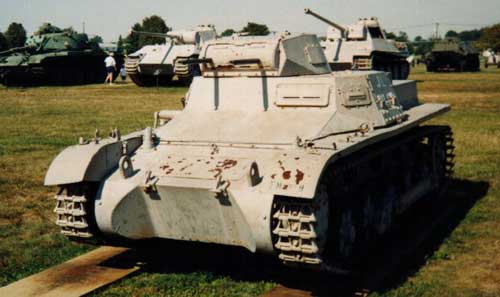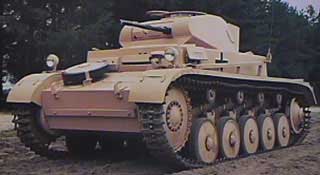 By late 1933, the Nazis rose to dominant power over Germany and with it came an ally to the
Panzer Program, Adolf Hitler. So in early 1934, production began on their first full production
panzer.
Originaly conceived in secret two years earlier, the "LKA1", was code named,
"Landwirtschaftlicher Schlepper", which translated means, agriculture tractor, abbreviated
La S. Later its designation would be changed to the familiar Pz Kpfw I.
By late 1933, the Nazis rose to dominant power over Germany and with it came an ally to the
Panzer Program, Adolf Hitler. So in early 1934, production began on their first full production
panzer.
Originaly conceived in secret two years earlier, the "LKA1", was code named,
"Landwirtschaftlicher Schlepper", which translated means, agriculture tractor, abbreviated
La S. Later its designation would be changed to the familiar Pz Kpfw I.
 Designed and produced obsolete from the start, this machine was cost effective and offered a
greatly needed "real" tank for training, however small it may be.
Designed and produced obsolete from the start, this machine was cost effective and offered a
greatly needed "real" tank for training, however small it may be.
In July of 1934 requirements were set for the Pz Kpfw II. Some of the specifications called for:
|
- A voice tube provided for communication between the commander and driver.
- 1ea 7.92-mm machine gun with 2,550 rounds.
- 1ea 20-mm main gun with 180 rounds.
- Hand cranked turret.
- A 3 man crew.
- Commander/gunner
- Loader/radio operator
- Driver

The 3 crew configuration was deficient as the above list shows, demanding a duel role of
some of its occupants.
LRIP stands for "low rate initial production", before a commitment is made on a particular
design for full production, lower cost version are built. In 1935, 25 such vehicles were built.
Later that same year after some minor changes 25 more were completed. After those were altered
slightly, 100 were built in 1936, the year Hitler openly ignored the Versailles Treaty and
excellerated Germany's rearmament program. Further changes from here brought a version selected
for full production which got under way in 1937. The earlier versions carried the Pz Kpfw I
suspension with the exception of an added boogie wheel that made the Pz Kpfw II 2 feet and 4 inches
longer. The Pz II above is a mid version model with the improved suspension but note there is
no cupola on the turret indicating that this is not latter version.
|
|

|
With World War II starting two years later
in 1939, the obsolete Pz Kpfw I and the Pz Kpfw II were the armour backbone that Blitzed
through Poland and started the Legend of German armour might. Eight months later the now
obsolete Pz Kpfw II made up nearly half the invading Armoured force that smashed quickly through
France, adding to the German military reputation. If you compare the Pz Kpfw II to some of the
French armour you'll see most of Germany's panzers were inferior in fire power and armour thickness,
however, German tactics and boldness, aided by air superiority, dominated beyond all expectations.
|
|
When Germany attacked Russia almost a year later in 1941, many Pz Kpfw II's filled the ranks in
the panzer divisions but unlike in France, Russian armour that appeared on the battlefield later
that year so outclassed the Pz Kpfw II that by 1942, they were used primarily in a reconnaissance
role. Until better German tanks could be built the chassis of the Pz Kpfw II was quickly used for
self-propelled gun conversions. Two well known versions were the Marder II that mounted for that
time a potent 75-mm gun and appeared in June 1942 and the Wespe (Waspe) that appeared in February
1943 and mounted a powerful 105-mm gun. These were only temporary answers, though well used, were
effective and helped for a time. Even the Pz Kpfw I in 1940, and used in France and throughout
the war, had its chassis converted to a gun platform to carry a 150-mm gun for infantry support.
That version was the Sig33.
In the autumn of 1942, the Germans put on the battlefield a tank that dominated the
battlefield. In fact it would not even be considered obsolete by the war's end 3 years later.
This was the Tiger I, perhaps the best known of all the Panzers. In service eight years after their
first production tank, consider this rapid advancement in armour development; 56 tons in 1942
from 5.6 tons in 1934. Also a 20-mm gun in 1935 to an 88-mm high velocity gun in 1942.
|
|
Pz kpfw I Ausf A
|
SPECIFICATIONS
|
Pz kpfw II Ausf F
|
|
5.4 tons
25 mph
2
13mm max
13' 3"
6' 9"
5' 8"
60hp Krupp 105
2ea 7.92mm machine guns
|
weight
speed
crew
armour thickness
length
width
height
engine
armament
|
9.35 tons
25 mph
3
35mm max
15' 9"
7' 6"
6' 8"
140hp Maybach HL 6-cylinder
1ea 20-mm canon/1ea 7.92mm machine gun
|
|